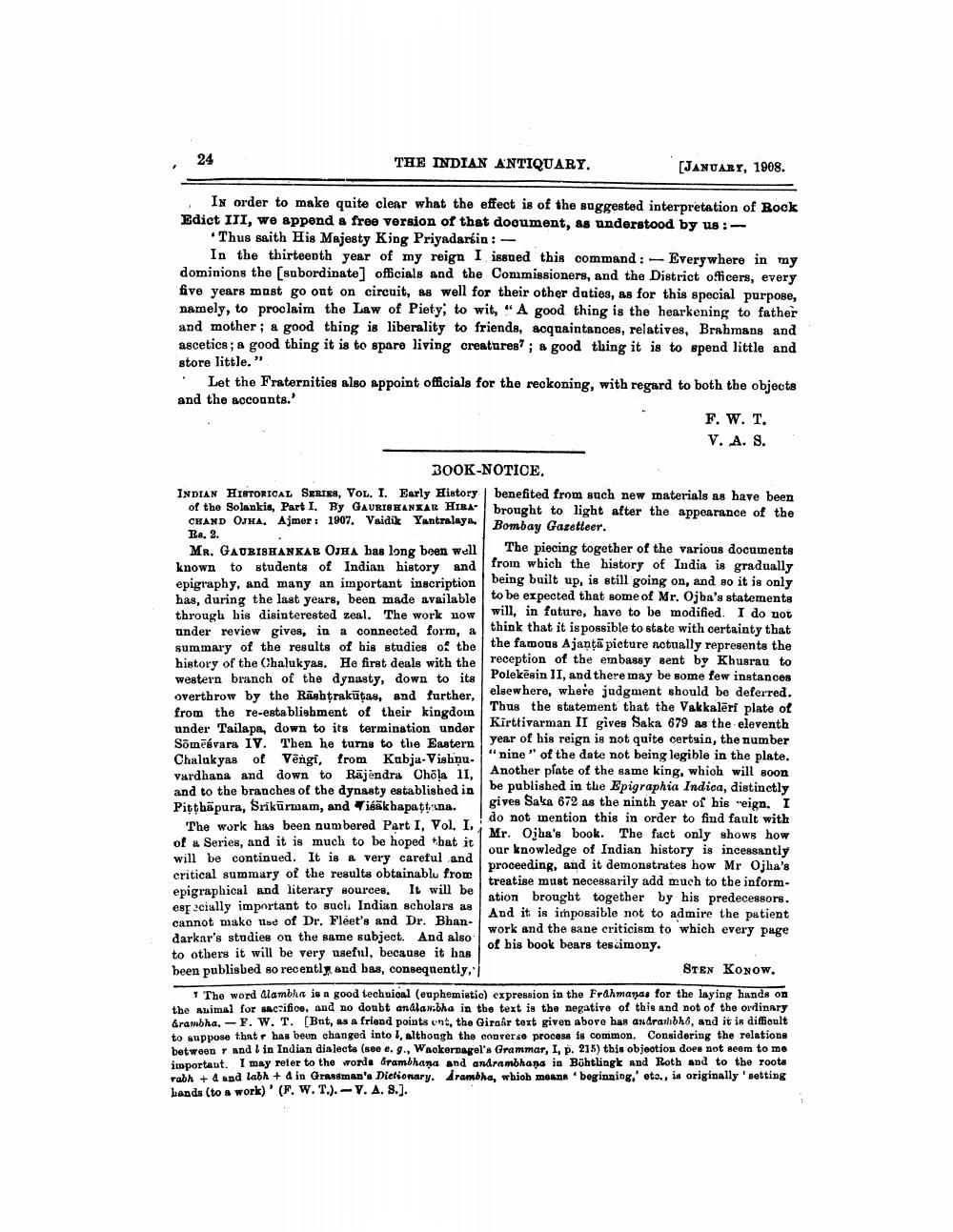________________
24
THE INDIAN ANTIQUARY.
(JANUARY, 1908.
• In order to make quite clear what the effect is of the suggested interpretation of Rock Edict III, we append a free version of that document, as understood by us :
• Thus saith His Majesty King Priyadarsin : -
In the thirteenth year of my reign I issued this command: - Everywhere in my dominions the (subordinate] officials and the Commissioners, and the District officers, every five years must go out on circuit, as well for their other duties, as for this special purpose, namely, to proclaim the Law of Piety, to wit, “A good thing is the hearkening to father and mother; a good thing is liberality to friends, acquaintances, relatives, Brahmans and ascetics; a good thing it is to spare living creatures?; a good thing it is to spend little and store little.”
. Let the Fraternities also appoint officials for the reckoning, with regard to both the objects and the accounts.'
F. W. T. V. A. S.
BOOK-NOTICE. INDIAN HISTORICAL SERIES, VOL. I. Early History benefited from such new materials as have been of the Solankis, Part I. By GAURISHANKAR HIBA- brought to light after the appearance of the CHAND OJHA. Ajmer : 1907. Vaidik Yantralaya.
Bombay Gazetteer. Rs. 2.
. MR. GAURISHANKAR OJHA has long been well The piecing together of the various documents known to students of Indian history and from which the history of India is gradually epigraphy, and many an important inscription being built up, is still going on, and so it is only has, during the last years, been made available to be expected that some of Mr. Ojba's statements through his disinterested zeal. The work now
will, in future, have to be modified. I do not under review gives, in a connected form, a think that it is possible to state with certainty that summary of the results of his studies of the
the famous Ajanţā picture notually represents the history of the Chalukyas. He first deals with the
reception of the embassy sent by Khusrau to western branch of the dynasty, down to its
Polekēsin II, and there may be some few instances overthrow by the Rashtrakūtas, and further,
elsewhere, where judgment should be deferred. from the re-establishment of their kingdom
Thus the statement that the Vakkalēri plate of under Tailapa, down to its termination under Kirttivarman II gives Saka 679 as the eleventh Sõmēsvara IV. Then he turns to the Eastern
year of his reign is not quite certuin, the number Chalukyas of Vēngi, from Kabja-Vishnu.
"nine" of the date not being legible in the plate. vardhana and down to Rajendra Chola II,
Another plate of the same king, which will soon and to the branches of the dynasty established in be published in the Epigraphia Indica, distinctly Pitthäpura, Srikūrmam, and Visakhapattana.
gives Saka 672 as the ninth year of his reign. I
do not mention this in order to find fault with The work has been numbered Part I, Vol. I,
Mr. Oiba's book. The fact only shows how of a Series, and it is much to be hoped that it
our knowledge of Indian history is incessantly will be continued. It is a very careful and
proceeding, and it demonstrates how Mr Ojha's critical summary of the results obtainablu from
treatise must necessarily add much to the informepigraphical and literary sources. It will be
ation brought together by his predecessors. especially important to such Indian scholars as
And it is impossible not to admire the patient cannot make use of Dr. Fleet's and Dr. Bhan
work and the sane criticism to which every page darkar's studies on the same subject. And also
of his book bears tescimony. to others it will be very useful, because it has been publisbed so recently and bas, consequently, i
STEN KONOW. The word lambha is a good technical (euphemistic) expression in the Frahmanas for the laying hands on the animal for sacrifice, and no doubt andlan.bha in the text is the negative of this and not of the ordinary Arambha, F. W. T. But, as a friend points on the Giroar text given above has andrarbh, and it is difficult to suppose that has been changed into I, although the converse process is common. Considering the relations between 1 and I in Indian dialects (see e. 9., Wackernagel's Grammar, I, P. 215) this objection does not seem to me important. I may refer to the wordo Arambhana and andrambhana in Bühtlingk and Roth and to the roots rabh + d and labh + d in Grassman's Dictionary. Arambha, which means 'beginning.' ets., in originally setting bands (to a work) (F. W.T.). -V. A.S.).




